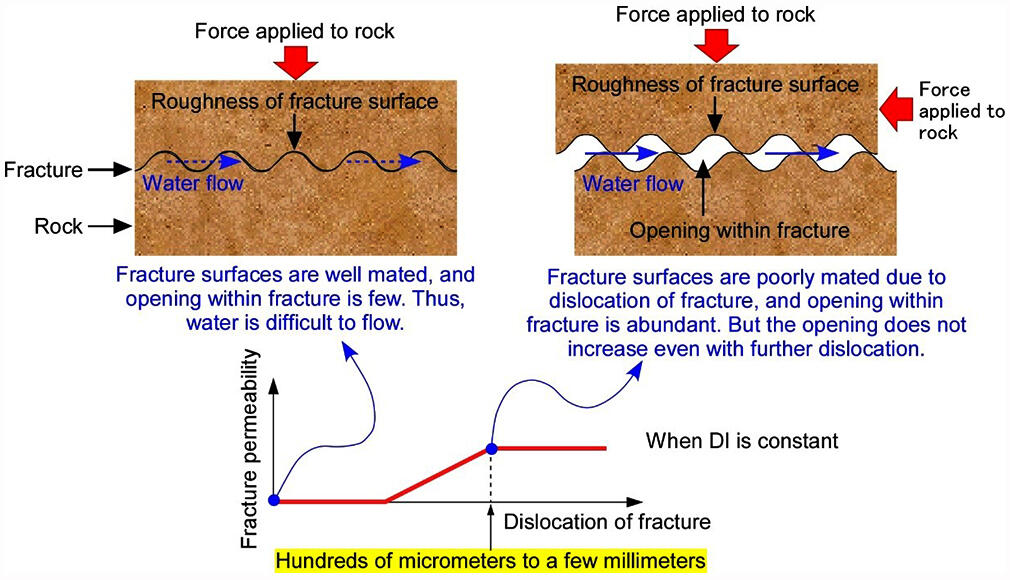Eiichi Ishii, Chief Researcher at the Horonobe Deep Underground Research Center, Sector of Nuclear Fuel, Decommissioning and Waste Management Technology Development, Japan Atomic Energy Agency, announced that he has discovered a geological rule related to the ease of water flow (transmissivity) in deep underground fractures. During his investigation, he reviewed the borehole-investigation data from various sites within and outside Japan. He then performed simulations using the laboratory experiment data and clarified that the transmissivity of the main groundwater flow path (water path fracture) is determined by three factors: the force, or stress, applied to the rock, the hardness of the rock, and fracture interlocking. This result will lead to the design of efficient boring surveys for geological disposal sites for high-level radiation waste and exploration of underground CO2 reservoirs. The results were published in the December 5th issue of Engineering Geology, an international journal.
The underground layers of the Earth contain fractures and groundwater flows more freely through more transmissive fractures. Several previous boring surveys have found that the transmissivity of fractures (water-path fractures), which are detected as major groundwater streams, tends to decrease with increasing depth. However, it remains unclear what this trend depended on, other than depth.
From this background, Ishii investigated in detail the boring-investigation data from six locations, including Horonobe-cho, Hokkaido, Switzerland, Sweden, Finland, and the United Kingdom, which have abundant prior research cases and data. It was confirmed that there is a certain regularity in the value (known as the DI, ductility index) obtained by dividing the transmissivity (mCO2/s) of the major water-path fissures and the average stress applied to the rock by the tensile strength of the rock. The transmissivity of the underground fractures has an upper limit depending on the DI, and an approximate curve could be drawn with the data of the six strata.
In order to clarify the mechanism of this approximate curve, Ishii investigated how the transmissivity changes with changes in DI, based on the results of laboratory experiments. It was confirmed that the simulation results reproduced the approximate curves. Furthermore, for DI, the conditions required to reach each transmissivity value were examined by simulations.
Ishii found that the water transmissivity of water-path fractures is at their highest when the gap in the fracture is the largest, owing to the surface of the fracture being displaced and the uneven surfaces of the fracture becoming poorly interlocked. It was found that the susceptibility to gaps forming in the fractures depends on DI. The conditions necessary for the transmissivity of the fracture to be within the range of the simulation results were examined for 88 patterns. As a result, it was found that the gap became the largest when interlocking became poor due to a sheer displacement of between 0.05 to 2 mm. The simulation results also showed that if the displacement is any larger, the transmissivity does not increase. Conversely, the surface is scraped smooth and the fracture becomes smaller, making the water transmissivity low. Furthermore, Ishii confirmed the validity of this result by conducting a test to artificially displace underground fractures at the underground research facility of the Horonobe Deep Underground Research Center.

(Provided by JAEA)
In the test, it was confirmed that when DI was gradually decreased, the transmissivity gradually increased in a form that reproduced the approximate curve. It was also confirmed that in fractures where the transmissivity/DI relationship had already reached the value indicated by the approximate curve, even if the fractures were shifted by several centimeters by high-pressure water discharge, only an increase in transmissivity occurred corresponding to the decrease in DI.

(Provided by JAEA)
According to Director Ishii, "The relationship between the transmissivity of underground fractures and DI revealed in this study makes it possible to understand the ease of flow of fractures around geological disposal sites for high-level radioactive waste using a smaller number of boring surveys. In the process of searching for areas with lower transmissivity, the efficiency of the survey can be further improved. This finding can also be applied to the evaluation of the confinement performance of the reservoir in CO2 underground storage. In the field of geothermal, oil, and natural gas resource development, it will also be useful in implementing measures to increase the transmissivity of fractures from the perspective of improving productivity."
This article has been translated by JST with permission from The Science News Ltd.(https://sci-news.co.jp/). Unauthorized reproduction of the article and photographs is prohibited.




